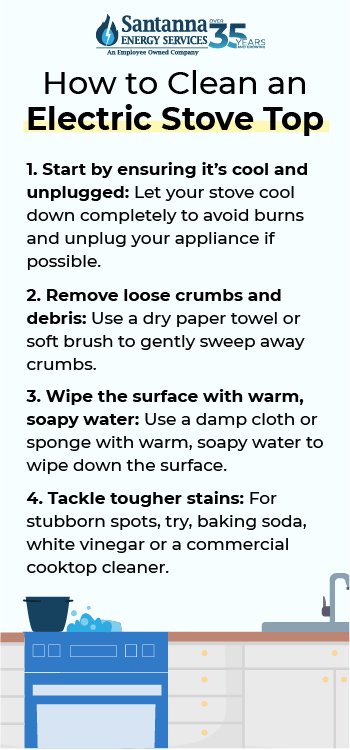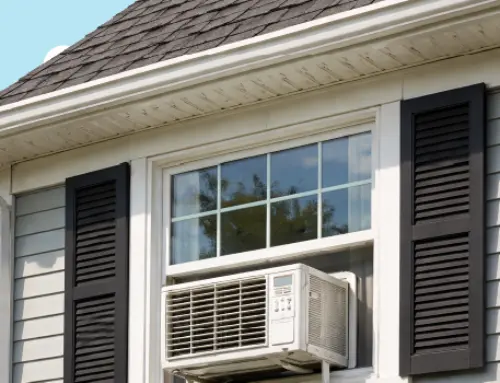How to Clean Your Electric Stove Top and Help It Use Less Energy
by Jenna Mendez
18.6 min read

Your electric stovetop works hard every day, from simmering soups, searing steaks, and holding up under the occasional boil-over. But over time, spills, grease, and burnt-on residue can do more than make it look messy. They can also make your stove work harder, waste electricity, and even shorten its lifespan.
In this blog, we'll show you the step-by-step instructions on how to clean a stovetop using safe, effective methods that protect your appliance while helping it use less energy. You'll also learn which products to use and which to avoid, how to prevent damage, and simple cooking habits that can make a noticeable difference on your energy bill.
Sure, a clean kitchen is great. But a clean, efficient kitchen? That's even better. Read on and power up your kitchen efficiency!
Key Points of This Article:
- A clean electric stove top heats more efficiently, lasts longer, and keeps your kitchen safer.
- Clean coils make better contact with cookware, helping food cook faster while using less energy.
- The right cleaning products protect your stove, while harsh or abrasive ones can cause damage.
- Wiping your stove after every use prevents crumbs, grease, and spills from hardening into tough stains.
- A quick daily wipe with a damp cloth or sponge keeps your stove top smooth and energy efficient.
Your electric stovetop works hard every day, from simmering soups, searing steaks, and holding up under the occasional boil-over. But over time, spills, grease, and burnt-on residue can do more than make it look messy. They can also make your stove work harder, waste electricity, and even shorten its lifespan.
In this blog, we'll show you the step-by-step instructions on how to clean a stovetop using safe, effective methods that protect your appliance while helping it use less energy. You'll also learn which products to use and which to avoid, how to prevent damage, and simple cooking habits that can make a noticeable difference on your energy bill.
Sure, a clean kitchen is great. But a clean, efficient kitchen? That's even better. Read on and power up your kitchen efficiency!
Why a Clean Stove Top Matters for Energy Efficiency
Most people clean their stovetop simply because it looks dirty, but a buildup of grease, food residue, and burnt-on spills can do more than affect appearances. These layers of grime make your stove use more electricity because they block heat transfer, forcing burners to stay on longer just to reach the right temperature.
This puts extra strain on the heating elements, which can cause uneven heating, wasted energy, and a shorter appliance lifespan. It also creates a safety risk since leftover grease or debris can smoke or even catch fire during high-heat cooking.
Over time, those extra minutes of energy use with each meal add up on your monthly bill, especially if you cook often. Keeping your stovetop clean not only makes your kitchen look better but also helps it run efficiently, last longer, and use less energy.
Preparing Your Electric Stove for Cleaning: Safety First
Before you start cleaning, take these quick steps to protect both yourself and your stove:
- Turn it off completely: Switch off the stove and, if possible, unplug it or shut off the circuit breaker. This helps prevent any chance of electric shock.
- Let it cool down fully: Wait until all burners and surfaces are completely cool to avoid burns.
- Remove loose items: Take off cookware, utensils, or anything sitting on the stovetop.
- Use the right tools: Have a soft cloth, sponge, or approved scraper ready. Avoid anything abrasive that could scratch the surface.
- Choose safe cleaners: Stick to mild soaps, baking soda, vinegar, or products made for stovetops and avoid harsh chemicals or flammable cleaners.
- Protect delicate surfaces: For glass or ceramic tops, be extra careful not to drop anything heavy while cleaning.
Taking a few minutes to prepare not only makes the job easier but also keeps your appliance in good shape and ensures your safety.
How to Clean an Electric Stove Top
Keeping your electric stovetop clean is not just about looks; it also helps your appliance heat efficiently, last longer, and stay safe to use. If you are wondering how to clean electric stovetop surfaces properly, here is a step-by-step guide you can follow:
- Start by ensuring it's cool and unplugged. Before you touch anything, let your stove cool down completely to avoid burns. If you can, unplug it or switch it off at the circuit breaker to eliminate any chance of electric shock.
- Remove loose crumbs and debris. Use a dry paper towel, soft brush, or handheld vacuum to gently sweep away crumbs, food particles, and loose grease. This prevents scratching during the cleaning process.
- Wipe the surface with warm, soapy water. Use a damp cloth or sponge with warm, soapy water to wipe down the surface.
- Tackle tougher stains. For stubborn spots, we've found that applying one of the following solutions before gently scrubbing with a soft cloth or non-abrasive brush gives your stovetop a really good clean:
- Baking soda paste: Mix baking soda with a little water until it forms a thick paste.
-
- White vinegar: Great for dissolving mineral deposits and cutting grease.
-
- Commercial cooktop cleaner: Choose a cleaner specifically designed for glass, ceramic, or enamel stovetops.
- Rinse and dry thoroughly to prevent streaks. After cleaning, wipe the surface with a clean, damp cloth to remove any soap or cleaner residue. Dry with a soft, lint-free towel to prevent streaks or water spots.

How to Clean an Electric Coil Stove Top
Electric coil stoves are known for being durable and easy to maintain, but regular cleaning is essential to keep them heating efficiently and lasting longer. If you have been wondering how to clean an electric coil stovetop safely, here is a simple step-by-step guide to follow:
- Turn off and unplug the stove.
Allow the coils to cool completely before handling. Unplugging prevents electrical hazards. - Remove the coils carefully.
Lift each coil slightly and pull it straight out of its socket without forcing it. Set the coils aside gently to avoid bending the connection prongs. - Clean the drip pans.
Take out the drip pans under each coil. Wash them in warm, soapy water using a non-abrasive sponge. - Wipe down the coils.
Use a damp cloth to remove food debris or grease from the coils. Never submerge them in water or place them in the dishwasher, as moisture can damage the internal electrical wiring. - Clean the stove surface.
Wipe the area under the coils with warm, soapy water. For stubborn residue, apply a small amount of baking soda paste, let it sit, then wipe clean. - Reassemble and check connections.
Once everything is completely dry, return the drip pans and push the coils back into place until firmly seated.
Energy Tip: A clean coil makes better contact with cookware, which heats food faster and uses less electricity.
How to Clean a Burnt Electric Stove Top
Burnt-on spills, especially from sugar or thick sauces, are some of the toughest messes to deal with in the kitchen. Here's a step-by-step method for cleaning burnt electric stovetop surfaces safely and effectively:
- Let the stove cool completely.
Never try to clean while the stove is hot. Not only can this cause burns, but it can also make the residue even harder to remove once it bakes in. - Soften the residue.
Cover the burnt area with warm, soapy water and lay a damp cloth or towel over it for 15–30 minutes. This loosens the buildup and makes it much easier to wipe or scrape away without damaging the surface. - Use a cooktop scraper (for glass tops).
Hold the scraper at a 45-degree angle and gently push the residue off. Make sure you use light pressure to avoid scratching. - For heavy buildup, repeat in layers.
Don't force all the residue off in one go. Instead, reapply baking soda paste or vinegar spray, let it sit, then scrape again. Working in layers helps protect your cooktop. - Rinse and dry completely.
After removing the residue, wipe the surface with a clean, damp cloth to get rid of any cleaner left behind. Finish by drying with a microfiber cloth to prevent streaks and water spots.
Pro Tip: The quicker you clean up spills, especially sugary ones, the easier they are to remove. Acting fast also prevents residue from insulating the burner, which can make your stove use more energy every time you cook. But of course, make sure the cooking surface isn't hot! If you act too quickly, you could burn yourself. Always put your safety first.
My Experience Cleaning an Electric Stove Top
As always, we're here to help. That's why I've tested three different methods of cleaning an electric stovetop, so you don't have to. Here's what I found from my tests:
Baking Soda: Best for Light Messes
The first time I tried to tackle stubborn, cooked-on food that had been on my stove for a few days (I know, I was tired), I went straight for baking soda. We cook a lot of homemade French fries and pasta in my house, so we have crumbs and stuck-on food on our stove top all the time.
I sprinkled it over the trouble spots, added a little water to make a paste, and let it sit. After about 15 minutes, I could scrub gently with a sponge, and most of the residue lifted right off.
I found that baking soda worked best on burnt food or greasy rings around the burners. I used a really gentle cloth so when I scrubbed, it didn't scratch the surface.
Warm Soapy Water: Good Quick Clean Up
On another occasion, I tried warm, soapy water for everyday messes.
I found that this method was the quickest and easiest. Just a soft sponge and a few drops of dish soap. It didn't do much for tough stains and definitely didn't stand a chance against tough, stuck-on food.
But it was perfect for fresh spills or grease that occur right after cooking. I liked this method for regular upkeep since it only took a few minutes and didn't require any waiting.
Cleaning with Foamy Stove Top Cleaner: Best for REALLY Tough Messes
Finally, I tested a foaming degreaser from the store. I sprayed it on, waited a few minutes until the foam turned clear, and wiped it away.
The foam clung to the surface and worked really well on greasy film, leaving the stove shiny without much effort. I DID have a lot of food stuck on there from the other day, so I had to spray the top a few times to really get all the food off, but I will say, it worked like magic!
I picked up Zep from my local Home Depot, and let me tell you, GAME CHANGER! And it smelled good too!
This solution gave me a serious deep clean and left my stovetop shiny.
Common Cleaning Mistakes to Avoid on Your Electric Stove Top
Even with the best intentions, some cleaning habits can do more harm than good. Here are the most common mistakes to watch out for while cleaning your electric stovetop:
- Scrubbing with abrasive pads or steel wool: These can scratch glass and ceramic surfaces, making them harder to clean in the future and potentially affecting heat transfer.
- Using harsh or corrosive chemicals: Products with ammonia, bleach, or strong solvents can damage finishes, discolor surfaces, and release fumes when heated.
- Cleaning while the stove is still hot: Not only is this a burn risk, but certain cleaners can bake onto the surface, making stains harder to remove.
- Letting spills sit too long: The longer spills stay on the stove, the more likely they'll burn into the surface and require heavy scrubbing, which is a waste of time and energy.
- Soaking electric coil burners: Submerging them in water can damage electrical components and cause them to fail.
- Skipping the drip pans and edges: Grease and residue in these spots can affect heat efficiency and even become a fire hazard over time.
Choosing the Right Cleaning Products for Your Electric Stove Top
The products you choose matter, not just for getting your stove clean, but for protecting it so it lasts longer and runs efficiently. Using the wrong cleaner can scratch, discolor, or even damage the heating elements. Here's what's safe, what's risky, and why it matters:
Our Picks for the Best Products to Use for Cleaning Your Electric Stove Top
- Mild dish soap and warm water are gentle enough for daily cleaning and will not harm the surface of your stove.
- Baking soda paste works as a natural, non-abrasive cleaner that is effective for stuck-on food and light stains.
- White vinegar is excellent for cutting through grease and removing mineral deposits without scratching the cooktop.
- Commercial cooktop cleaners should be used if they are specifically labeled for glass, ceramic, or enamel stovetops, as they are designed to clean safely and effectively.
- Soft cloths or non-abrasive sponges are ideal for wiping down the surface, with microfiber being the best option to avoid scratches and streaks.
What Products to Avoid When Cleaning Your Stove Top:
- Abrasive pads or steel wool should never be used because they can scratch glass and ceramic, making stains harder to remove in the future and reducing heat efficiency.
- Harsh chemical cleaners that contain ammonia, bleach, or strong solvents can discolor the surface and may release harmful fumes when the stove is heated.
- Oven cleaner sprays are designed for oven interiors and are too strong for stovetops, which means they can cause permanent damage.
- Excess water should be avoided because it can seep into electrical parts, leading to shorts or corrosion, especially on coil stoves.
- Flammable cleaners should never be used near burners, even when the stove is off, because any residual fumes can ignite once the stove is turned back on.
How Often Should You Clean Your Electric Stove Top for Maximum Efficiency?
No matter what type of stove you own, whether it is induction, electric, or gas, it is important to give it a quick wipe-down after every use. This simple routine keeps crumbs, splatters, grease, and other residue from building up and baking onto the surface, which becomes much harder to remove later on.
For electric stovetops in particular, keeping a smooth, clean surface makes a big difference because it allows heat to transfer more efficiently to your cookware. That means your stove does not have to waste extra energy heating through layers of burnt-on food.
The easiest way to maintain a clean electric stovetop is by wiping it daily with a damp cloth or sponge once it has cooled down. Over time, this small step not only keeps your kitchen looking neat but also helps your stove run more efficiently, last longer, and use less electricity.
Energy Saving Tips for Electric Stove Owners
Making small changes in how you cook can help your electric stove use less energy, save you money, and even make your meals cook faster. Here are some simple tips that really work:
- Choose a pan that fits the burner: Using a small pan on a large burner wastes heat. Instead, choose a pan that covers the burner completely so heat goes into your food, not the air.
- Use flat-bottom cookware: Pots and pans with warped bottoms don't make full contact with the heating element, slowing cooking times and increasing energy use.
- Keep your cookware clean: A clean pan bottom transfers heat more efficiently, so always wash away grease or burnt residue before cooking.
- Cook with lids on: Trapping heat inside the pan can cut cooking times, which reduces how long the burner needs to stay on.
- Turn burners off a little early: Electric burners stay hot for several minutes after being turned off. Use that residual heat to finish cooking.
- Use the right burner for the job: For simmering or small portions, use a smaller burner to avoid wasting excess heat.
- Batch cook when possible: If you're already heating up the stove, make extra portions to save energy on future meals.
- Clean your stove regularly: Food residue can insulate the heating element, making it work harder to reach the desired temperature.
- Tips for Troubleshooting Common Problems With Your Electric Stove Top
Sometimes, after giving your electric stovetop a good cleaning, you might notice it's not working quite like it did before. Most of the time, these issues are minor and easy to fix at home but in some cases, you may need to call in a professional.
Let's break it down:
If Your Burners Won't Heat Evenly…
It's often because the burner coil isn't seated correctly in its socket. Make sure it's fully pushed into place and that the prongs are straight. While you're at it, check the coil connections for dirt, grease, or corrosion.
A quick wipe with a dry cloth can help restore proper contact. If you have a smooth glass or ceramic top, uneven heating could also be caused by warped cookware rather than the stove itself.
If the Stove Smokes After Cleaning…
It's usually due to leftover cleaner or residue burning off when the burner heats up. This is especially common if you've used too much soap, vinegar, or haven't rinsed thoroughly.
Turn on the burner at a low setting for a few minutes to burn off the residue, and then wipe the surface with a damp cloth. However, if the smoke smells like burning wires or plastic, turn off the stove immediately, unplug it, and have it inspected. This could indicate an electrical problem.
When to Call a Technician vs. A DIY Fix
Simple problems like reseating coils, cleaning contacts, or removing leftover cleaner can usually be handled at home. But if you notice sparks, a persistent burning smell, tripped breakers, or burners that still won't heat after basic checks, it's time to contact a qualified appliance repair technician.
Signs It's Time to Replace Your Stove Top
Even a well-maintained stove won't last forever. Over time, parts wear out, performance drops, and safety or energy issues can start to appear. If you've noticed any of these signs, it may be time to start shopping for a replacement. Here are some of the most common signs that your cooktop needs to be replaced:
Uneven Heating
If one burner isn't heating like it used to or the temperature feels inconsistent, it could be the first sign something's wearing out. When this starts happening to multiple burners, it's usually a clue that the whole stove may be nearing the end of its life.
Too Many Repairs
If you've had to call the repair person more than a couple of times recently, or the cost of fixing it keeps climbing, it might be time to stop pouring money into it. A good rule is that if the repair bill is more than half the cost of a new stove, replacement is usually the smarter choice.
Physical Damage
Rust, cracks, or warped parts may look cosmetic, but they can be safety hazards, leading to sparks or even gas leaks. If your stove looks worn down or unsafe, replacing it is the safer option.
Rising Energy Bills
Older stoves often use more gas or electricity than newer, energy-efficient models. If your energy costs have increased and nothing else has changed, your stove could be the culprit.
Outdated Features
If your stove lacks modern safety features, has awkward or unreliable controls, or just makes cooking feel like a chore, upgrading can make cooking easier, safer, and more enjoyable.
FAQs
What is the safest way to clean an electric stove top without scratching it?
Use a soft cloth or non-abrasive sponge with warm, soapy water. For stubborn spots, apply baking soda paste or a cleaner designed for your stove type, and avoid steel wool or abrasive pads.
Can you clean a glass stovetop with baking soda?
Yes. Baking soda is non-abrasive and safe for glass cooktops. Sprinkle it on the surface, spray with water or vinegar, let it sit, then wipe clean.
How long do electric stoves last?
Most electric ranges last about 13–15 years with proper care.
Should I unplug my electric stove before cleaning it?
Yes. Unplugging or switching it off at the breaker reduces the risk of electrical shock, especially when cleaning near burners or controls.
How long should I wait after cooking before cleaning?
Wait until the stove top is completely cool, usually 30 to 60 minutes, to prevent burns and avoid cleaner streaking from heat.
Can cleaning while warm cause damage?
Yes. Cleaning while warm can cause cleaners to bake onto the surface, making stains harder to remove, and may also cause cracks on glass tops from sudden temperature changes.
Does food residue really make an electric stove less efficient?
Yes. Burnt-on residue acts as an insulator, forcing the heating element to run longer to reach the right temperature.
Does a dirty stove take longer to heat up?
Yes. Food and grease buildup interfere with heat transfer from the element to your cookware.
Can I use vinegar to clean my electric stove top?
Yes. White vinegar is safe for most stovetops and helps cut grease and dissolve mineral deposits. Avoid using it on hot surfaces to prevent streaking.
Keeping your electric stovetop clean isn't just about appearance; it also helps your appliance heat more efficiently, last longer, and use less electricity with every meal you make. Simple habits like wiping it down after each use, cleaning spills before they harden, and using the right products can make a noticeable difference over time.
And just like a well-maintained stove keeps your cooking consistent, having a steady energy plan can keep your home running smoothly no matter the season. With Santanna's Unlimited Energy Plan, you can enjoy the comfort of knowing your supply charges stay predictable, giving you one less thing to worry about while you focus on what matters most at home.* Interested in learning more? Visit here for the full scoop.
* Restrictions apply. Enrollment based upon program eligibility. Customers using more than 125% of normal monthly usage as determined by Santanna may be required to switch plans.
Jenna Mendez is a Midwest native with lifelong roots in Illinois and time spent in Ohio during college, giving her a deep understanding of the Midwest region’s people, climate, and energy needs. She brings firsthand experience and local insight to topics that matter to Midwest homeowners, especially energy efficiency, sustainability, and home living. Jenna specializes in writing about eco-friendly living, all things Midwest, renewable energy, and practical ways to reduce energy costs. Jenna brings a trusted, and local hometown voice to every article she writes, helping readers live well, and sustainably, right where they are.







